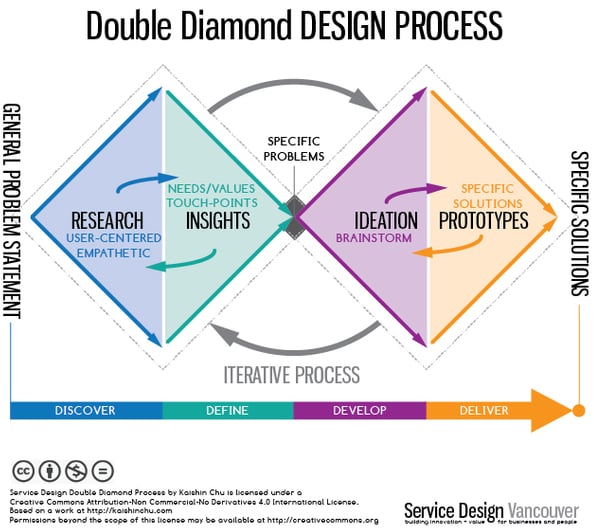
How to Apply Design Thinking to Selling & Buying
If you read a lot of business and leadership content or spent much time in product development circles, you’ve likely heard the term “design thinking.” Design thinking is a customer-centric way to approach problems and innovation, and according to McKinsey & Company, it’s one of the most effective ways to differentiate your company and products from competition.
According to their data, the best design performers increase revenue at twice the rate of their industry competitors.
So I got curious about how we can apply design thinking to sales to achieve similar outcomes. Here’s what I learned.
What Is Design Thinking?
According to the Harvard Business review, “design thinking is a mindset and approach to problem-solving and innovation anchored around human-centered design.” Design thinking prioritizes the customer’s needs above all else, and involves an iterative process that is agile and responsive to actual customer behavior and feedback.
McKinsey & Company define several important features of strong design thinking:
Design is a top-level management issue. Someone in the c-suite is a designer.
- Design is done WITH people, not FOR people
- Design embraces the full user experience
- Understand WHY your buyers want what they want
- Understand HOW your buyers behave when they interact with your brand
- Use feedback loops to design in real time
- Iterate agilely based on user feedback
One way to visualize the Design Thinking process is via the “double diamond.”

Variation of the double diamond from Service Design Vancouver
Here you see a process from discover, to define, to develop, to deliver.
What distinguishes design thinking from other forms of linear problem-solving and innovation, is the iterative framework centered heavily on the consumer.
The discovery process focuses on empathetically understanding the buyer. In some companies, this involves anthropological research into how individuals interact with the brand and why they choose the brand’s products. In other cases, it may be based on customer interviews or simply observing customer behavior.
Based on this research, insights are drawn that are also buyer-focused. What are the buyer’s needs, touchpoints, and values?
The process can always go backward for more information and to maintain and increase focus on the buyer.
A problem in most buying and sales motions is that we rush past the “problem diamond” to the “solution diamond.”
Insights can be used to identify specific problems to solve, which then leads to ideation and brainstorming, then the design of specific solutions and prototypes. Again, the process always returns backward to gather more information and remain responsive to buyer needs.
Thus, design thinking leads to outcomes that start from the very beginning with the buyer’s full experience, and delivers an agile, constantly evolving experience that is responsive to the buyer’s actual lived experience, needs, values, and preferences.
How Can We Apply Design Thinking in Sales?
Any time we focus on the buyer’s needs in sales, we win. Design thinking gives us a framework and mindset shift that enables us to fully center our planning and design around how, why, and when buyers interact with us.
The double diamond approach can be used for everything from how we think about our product positioning and our sales strategy to how we have sales conversations with potential buyers.
In Sales Conversations
A sales conversation using the double diamond might follow this structure:
- Discover: Ask questions and listen deeply to understand the buyer’s actual needs, and to get below the surface to understand the root problems they are trying to solve. Empathize with their position and understand it from their point of view. Engage all relevant stakeholders
- Define: Use insights from the discover phase to identify the buyer’s most important touchpoints, needs, and values
- Develop: Brainstorm with the customer to create ideas for how they might best solve their problems in a way that aligns with their needs
- Deliver: Share a prototype of a solution that meets all of their needs
By placing the buyer at the center of the conversation, sellers can customize the solution to the buyer’s why and how they actually want to solve the problem. Additionally, the iterative process enables the seller to continuously respond to feedback from the buyer to optimally design the solution that they will respond to best.
In Sales Strategy and Process
To take a step back, the double diamond can also be applied at the strategic sales level by starting with a discovery of how buyers behave during the sales process, using those insights to define what the buyer most needs, developing ideas for improving the sales strategy, and then delivering a strategy that is aligned with the buyer.
This work can then be used to inform a sales process that is based in design thinking and therefore in the genuine way that buyers work and buy.
This is especially valuable for complex B2B sales, where insight into the needs and values of multiple stakeholders can create differentiation and reduce resistance to change within the organization.
In this way, design thinking can work at multiple levels within your sales organization to elevate your performance, and win more deals.

By George Brontén
George is the founder & CEO of Membrain, the Sales Enablement CRM that makes it easy to execute your sales strategy. A life-long entrepreneur with 20 years of experience in the software space and a passion for sales and marketing. With the life motto "Don't settle for mainstream", he is always looking for new ways to achieve improved business results using innovative software, skills, and processes. George is also the author of the book Stop Killing Deals and the host of the Stop Killing Deals webinar and podcast series.
Find out more about George Brontén on LinkedIn







